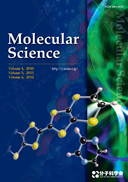14 巻, 1 号
選択された号の論文の6件中1~6を表示しています
- |<
- <
- 1
- >
- >|
Award Accounts
-
2020 年 14 巻 1 号 p. A0109-
発行日: 2020年
公開日: 2020/08/27
PDF形式でダウンロード (1505K) -
2020 年 14 巻 1 号 p. A0110-
発行日: 2020年
公開日: 2020/08/27
PDF形式でダウンロード (1430K) -
2020 年 14 巻 1 号 p. A0111-
発行日: 2020年
公開日: 2020/08/27
PDF形式でダウンロード (1673K) -
2020 年 14 巻 1 号 p. A0112-
発行日: 2020年
公開日: 2020/08/27
PDF形式でダウンロード (2773K)
Review
-
2020 年 14 巻 1 号 p. A0113-
発行日: 2020年
公開日: 2020/08/27
PDF形式でダウンロード (2646K) -
2020 年 14 巻 1 号 p. A0114-
発行日: 2020年
公開日: 2020/08/27
PDF形式でダウンロード (12669K)
- |<
- <
- 1
- >
- >|
